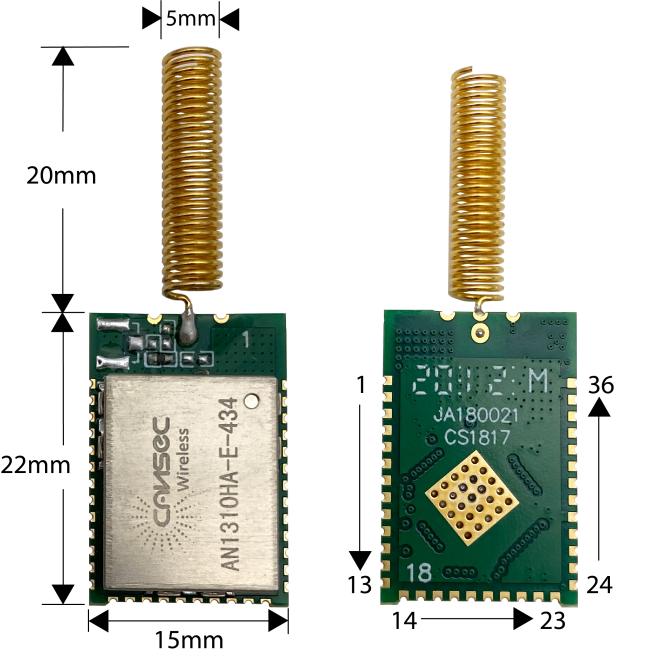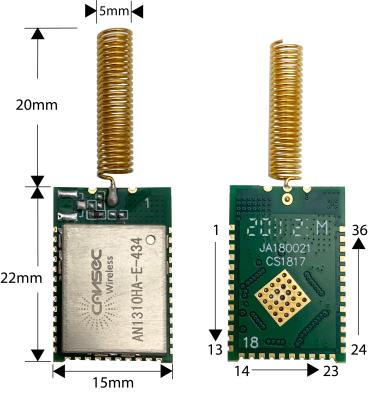1.
The
AN1310
module
is
designed
based
on
CC1310F128.
The
CC1310
device
is
the
first
part
in
a
Sub-1-GHz
family
of
cost-effective,
ultra
low
power
wireless
MCUs.
The
CC1310
device
combines
a
flexible,
very
low
power
RF
transceiver
with
a
powerful
48-MHz
Cortex-M3
microcontroller
in
a
platform
supporting
multiple
physical
layers
and
RF
standards.
A
dedicated
Radio
Controller
(Cortex-M0)
handles
low-level
RF
protocol
commands
that
are
stored
in
ROM
or
RAM,
thus
ensuring
ultra
low
power
and
flexibility.
The
low-power
consumption
of
the
CC1310
device
does
not
come
at
the
expense
of
RF
performance;
the
CC1310
device
has
excellent
sensitivity
and
robustness
(selectivity
and
blocking)
performance.
2.
The
CC1310
device
is
a
highly
integrated,
true
single-chip
solution
incorporating
a
complete
RF
system
and
an
on-chip
DC-DC
converter.
3.
Sensors
can
be
handled
in
a
very
low-power
manner
by
a
dedicated
autonomous
ultra
low
power
MCU
that
can
be
configured
to
handle
analogue
and
digital
sensors;
thus
the
main
MCU
(Cortex-M3)
is
able
to
maximize
sleep
time.
4.
The
CC1310
power
and
clock
management
and
radio
systems
require
specific
configuration
and
handling
by
software
to
operate
correctly.
This
has
been
implemented
in
the
TI
RTOS,
and
it
is
therefore
recommended
that
this
software
framework
is
used
for
all
application
development
on
the
device.
The
complete
TI-RTOS
and
device
drivers
are
offered
in
source
code
free
of
charge.
Features
-
Built
in
CC1310F128
Sub-1-GHz
RF
System-On-Chip
(SOC)
-
Size:15mm
X
22mmX3.2mm
-
Operating
Voltage:1.8V
to
3.8V
-
Operating
Temperature:
-20℃~+70℃
-
Storage
Temperature:
-40℃~+125℃
-
Microcontroller
-
Powerful
ARM
Cortex
–M3
-
Up
to
48MHz
Clock
Speed
-
128KB
of
In-System
Programming
Flash
-
8KB
of
SRAM
for
Cache
(or
as
General-Purpose
RAM
)
-
20KB
of
Ultralow
Leakage
SRAM
-
2-Pin
cJTAG
and
JTAG
Debugging
-
Supports
Over-the-Air
Upgrade
(OTA)
-
Ultralow
Power
Sensor
Controller
-
Can
Run
Autonomous
From
the
Rest
of
the
System
-
16-Bit
Architecture
-
2KB
of
Ultralow
Leakage
SRAM
for
Code
and
Data
-
Efficient
Code-Size
Architecture,
Placing
TI-RTOS,
Drivers
and
Bootloader
in
ROM
-
Peripherals
-
All
digital
Peripheral
Pins
Can
Be
Routed
to
Any
GPIO
-
Four
General-Purpose
Timer
Modules
(Eight
16-Bit
or
four
32-Bit
Timers,
PWM
Each)
-
12-Bit
ADC,
200
ksamples/s,
8-Channel
Analog
MUX
-
Continuous
Time
Comparator
-
Ultralow
Power
Clocked
Comparator
-
Programmable
Current
Source
-
UART
-
2
x
SSI
(SPI,
MICROWIRE,
TI)
-
I2C
-
I2S
-
Real-Time
Clock
(RTC)
-
AES-128
Security
Module
-
True
Random
Number
Generator
(TRNG)
-
Support
for
Eight
Capacitive
Sensing
Buttons
-
Integrated
Temperature
Sensor
-
Low
Power
-
Active-Mode
MCU:
48MHz
Running
Coremark:
2.5mA
(51μA/MHz)
-
Active-Mode
MCU:
48.5
CoreMark/mA
-
Active-Mode
Sensor
Controller
at
24
MHz:
0.4mA
+8.2μA/MHz
-
Sensor
Controller,
One
Wake
Up
Every
Second
Performing
One
12-Bit
ADC
Sampling:
0.95μA
-
Standby:
0.7μA
(RTC
Running
and
RAM
and
CPU
Retention)
-
Shutdown:
185nA
(Wakeup
on
External
Events)
-
RF
Section
-
Excellent
Receiver
Sensitivity
-124
dBm
Using
Long-Range
Mode,
-110dBm
at
50kbps
-
Excellent
Selectivity:
56dB
-
Excellent
Blocking
Performance:
90
dB
-
Programmable
Output
Power
up
to
+14
dBm


















